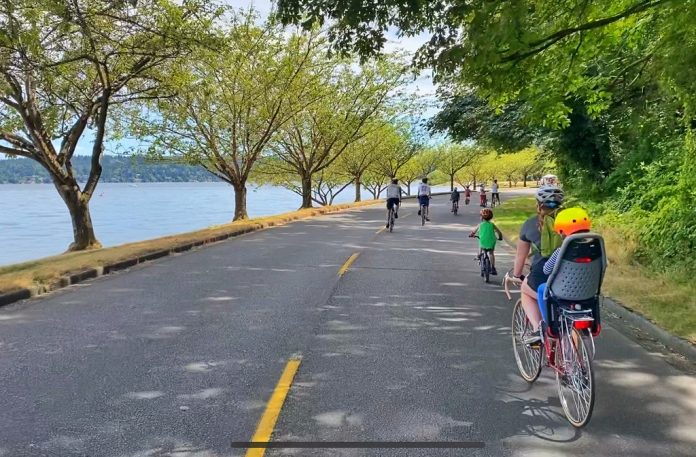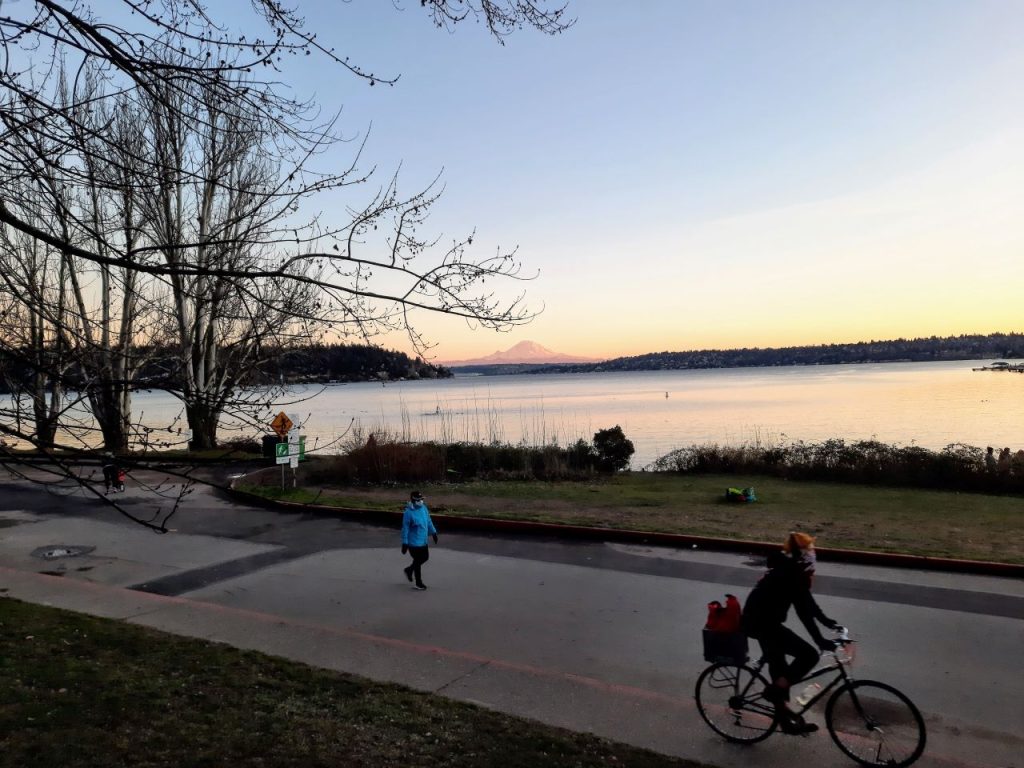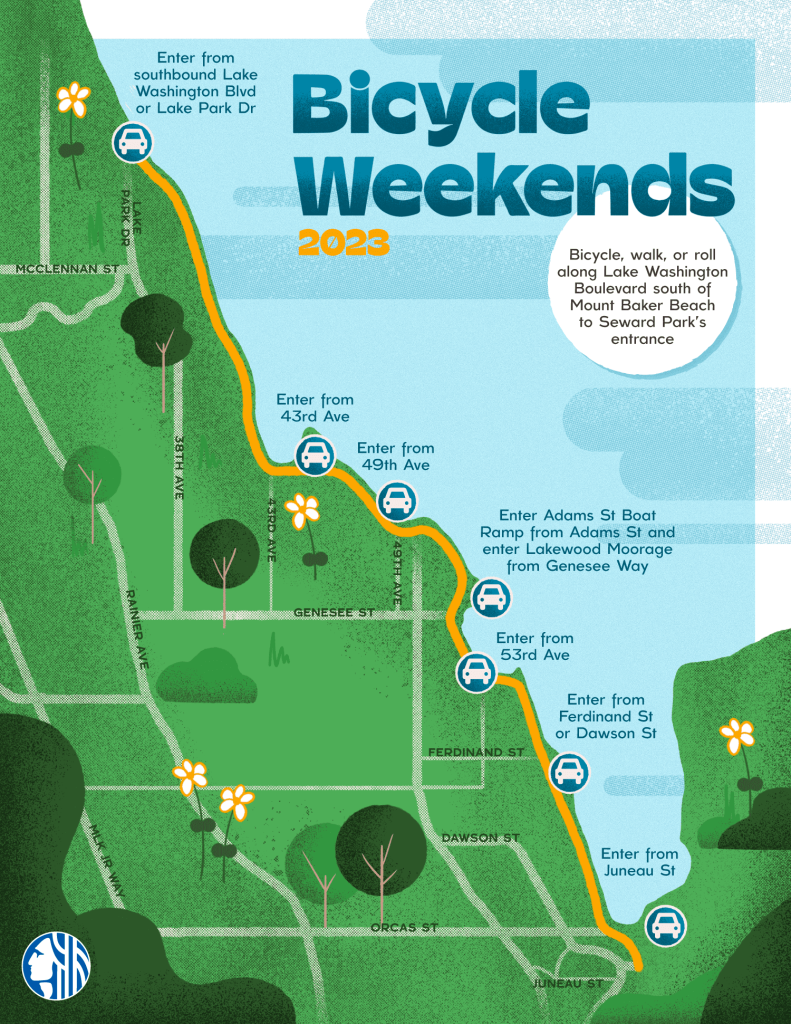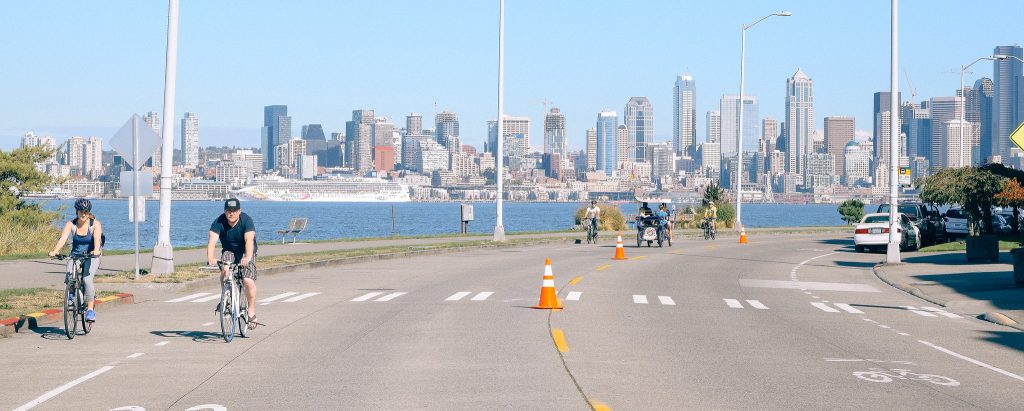
The Harrell Administration is prioritizing cars over people rolling and biking on Lake Washington Boulevard.
Seattle Parks and Recreation has announced the schedule for 2023’s set of open street events on Lake Washington Boulevard between Mount Baker and Seward Park. Now dubbed “Bicycle Weekends,” Bicycle Sundays have been a feature on the park-owned arterial street dating back to the late 1960s, with the two-lane street shut down to through traffic so it can be used by people biking, walking, and rolling. The first weekend of the year will be May 20 and 21, with open streets on nine additional weekends through mid-September.
The 2023 event dates are:
- May: 20-21; 27-28;
- June: 17-18; 24-25;
- July: 1-2; 15-16;
- August: 19-20; 26-27;
- September: 2-3; 16-17.
This year’s schedule represents a further scaling back of the amount of time that Lake Washington Boulevard will be a people-friendly open street, with barricades placed late on Saturday morning (by 10am) and removed well before sunset on Sunday at 6pm. Last year, barricades were placed by 7pm Friday evening and taken away by 7am Monday morning.

This significantly reduces the opportunities people have to enjoy the street on the limited number of weekends in the first place. Parkgoers may enjoy a leisurely roll or ride to Seward Park on a Sunday afternoon, but if they stick around past 6pm, they’ll be contending with speeding cars once more on their return journey. In other words, enjoying a Sunday sunset may be out of the picture for people rolling and biking. Disability rights activists have noted the narrow, busy sidewalks along Lake Washington are hard to use for disabled people. The open streets events greatly increase accessibility over the status quo.
“This time change reflects the call for Bicycle Weekends to be more predictable, consistent, and to reduce the impacts on evening and morning commutes,” the announcement from Seattle Parks in late April noted.
Walking and biking advocates, including Rainier Valley Greenways and Safe Streets, had been asking for the 2023 schedule to be more consistent than the 10 random weekends that were in place last year, and instead the city scaled back the hours while leaving the hard-to-track set of dates. The 2023 schedule even cuts out Labor Day, with no three-day weekends included in the schedule at all. In contrast, The Urbanist editorial board pushed for Lake Washington Boulevard to be permanently pedestrianized.

Lake Washington Boulevard only sees about 6,000 vehicle trips per day, a fraction of major arterial streets like Rainier Avenue and MLK Jr Way that drivers would most likely use as alternatives if Lake Washington Boulevard is closed to through traffic. The motorists who do use Lake Washington Boulevard almost universally exceed, according a speed study by the Seattle Department of Transportation (SDOT), which found more than 90% exceeded the posted 25 mph speed limit. The study found more than 20% drive faster than 35 mph along the narrow road frequented by people biking, which greatly increases the chance that a crash will be deadly.

Even during the open street events, drivers who live directly along the waterfront boulevard still able to access their homes. Seven access points will be available for people to access to park their vehicles, as highlighted by Seattle Parks and Recreation’s promotional material for the event, which highlights those parking areas but somehow omits both public transit access and safe bike routes to and from Lake Washington Boulevard. In the late 1960s when Bicycle Sundays first launched, bike rentals were available, but now things are BYOB.

The schedule’s announcement comes on the heels of the final meeting of the Lake Washington Boulevard Taskforce, a city-organized sounding board convened to hash out potential paths forward for the street, following a budget allocation in the next round of Seattle Parks District funding for a “protected path on parks property that can accommodate people using mobility devices, riding bicycles, and walking.” That taskforce, which included voices for additional walking and rolling options in the neighborhood and voices for maintaining vehicle traffic through the park, deadlocked at the final meeting in March when several members were denied a chance to vote by proxy.
The idea of moving forward with repurposing one general purpose lane on Lake Washington Boulevard into a two-way walking and rolling path was met with a 5 to 5 vote on the taskforce, essentially punting the idea back to the city where it will ultimately be resolved. At a late April meeting of the Seattle Board of Parks and Recreation Commissioners, Parks Superintendent AP Diaz sought to distance the work that his department is doing to create the open streets events this summer from the ongoing planning work largely happening within SDOT. But the scaled-back nature of the 2023 schedule seems like a signal of the city’s overall ambition around maximizing this public asset.
The Receding of Summer Open Streets in Seattle
Apart from a few scattered, privately-organized events like Capitol Hill Pride and Ballard Seafood Fest, Bicycle Weekends remains Seattle’s only publicly-organized large-scale summer open streets event. Elsewhere in the US, open streets festivals like CicLAvia in Los Angeles, Summer Streets in New York City, and Sunday Parkways in Portland offer an opportunity to leverage the underutilized assets that a city’s streets represent, particularly in off-peak hours.
As Seattle Parks itself noted in the outreach on the upcoming update to the citywide parks and open space plan, the city has grown 25% since 2010 and with park space largely staying the same, the city will need to get creative about using all of its public space for both recreation and transportation. With SDOT’s Stay Healthy Streets, also filling the same niche that open streets events did, largely staying out of the city’s most park-scarce neighborhoods like the U District and Belltown, there are some big opportunities that have been left untapped.
Seattle’s brief foray into hosting citywide open streets events, Seattle Summer Parkways in 2015 and 2016, had some execution and promotional issues, but showed promise. West Seattle, Ballard, Central District, and Rainier Valley streets became available for people of all ages and abilities to use for a brief amount of time. Mayor Jenny Durkan, on taking office in 2017, quickly tossed Summer Parkways overboard at the slightest budget crunch. But it may be time to give it another try.

Downtown could be a great place to start. Mayor Bruce Harrell’s Downtown Activation Plan, the broad outline of which was released in April, includes some potential open streets events downtown, but so far we haven’t seen any details of what that might look like. “Encourage more frequent closings of downtown streets for special events, such as on-street Pickleball competitions, the First Thursday Art Walks in Pioneer Square, street festivals and music concerts,” a fact sheet on the potential plan noted.
For now, the valuable few hours every month that Lake Washington Boulevard is fully accessible to walkers, bikers, and rollers will be incredibly beneficial to countless Seattle residents. But the trend of scaling back the schedule every year will hopefully come to an end, with the city seeing the value in expanding, not contracting, the use of its streetscapes for users of all types moving forward.
Ryan Packer has been writing for The Urbanist since 2015, and currently reports full-time as Contributing Editor. Their beats are transportation, land use, public space, traffic safety, and obscure community meetings. Packer has also reported for other regional outlets including BikePortland, Seattle Met, and PubliCola. They live in the Capitol Hill neighborhood of Seattle.

